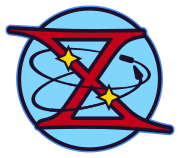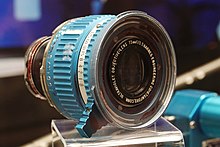
Apollo 9 was the third human spaceflight in NASA's Apollo program. Flown in low Earth orbit, it was the second crewed Apollo mission that the United States launched via a Saturn V rocket, and was the first flight of the full Apollo spacecraft: the command and service module (CSM) with the Lunar Module (LM). The mission was flown to qualify the LM for lunar orbit operations in preparation for the first Moon landing by demonstrating its descent and ascent propulsion systems, showing that its crew could fly it independently, then rendezvous and dock with the CSM again, as would be required for the first crewed lunar landing. Other objectives of the flight included firing the LM descent engine to propel the spacecraft stack as a backup mode, and use of the portable life support system backpack outside the LM cabin.
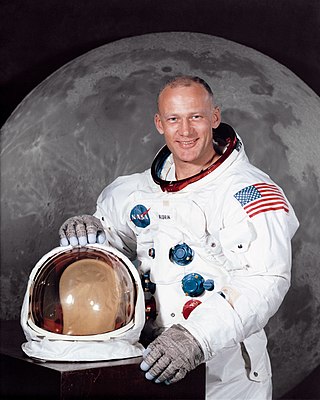
Buzz Aldrin is an American former astronaut, engineer and fighter pilot. He made three spacewalks as pilot of the 1966 Gemini 12 mission. He was the Lunar Module Eagle pilot on the 1969 Apollo 11 mission and became the second person to walk on the Moon after mission commander Neil Armstrong.

Michael Collins was an American astronaut who flew the Apollo 11 command module Columbia around the Moon in 1969 while his crewmates, Neil Armstrong and Buzz Aldrin, made the first crewed landing on the surface. He was also a test pilot and major general in the U.S. Air Force Reserve.

Gemini 3 was the first crewed mission in NASA's Project Gemini and was the first time two American astronauts flew together into space. On March 23, 1965, astronauts Gus Grissom and John Young flew three low Earth orbits in their spacecraft, which they nicknamed Molly Brown. It was the first U.S. mission in which the crew fired thrusters to change the size and shape of their orbit, a key test of spacecraft maneuverability vital for planned flights to the Moon. It was also the final crewed flight controlled from Cape Kennedy Air Force Station in Florida, before mission control functions were moved to a new control center at the newly opened Manned Spacecraft Center in Houston, Texas.

The Agena Target Vehicle, also known as Gemini-Agena Target Vehicle (GATV), was an uncrewed spacecraft used by NASA during its Gemini program to develop and practice orbital space rendezvous and docking techniques, and to perform large orbital changes, in preparation for the Apollo program lunar missions. The spacecraft was based on Lockheed Aircraft's Agena-D upper stage rocket, fitted with a docking target manufactured by McDonnell Aircraft. The name 'Agena' derived from the star Beta Centauri, also known as Agena. The combined spacecraft was a 26-foot (7.92 m)-long cylinder with a diameter of 5 feet (1.52 m), placed into low Earth orbit with the Atlas-Agena launch vehicle. It carried about 14,021 to 14,054 pounds of propellant and gas at launch, and had a gross mass at orbital insertion of 7,117 to 7,271 pounds.

John Watts Young was an American astronaut, naval officer and aviator, test pilot, and aeronautical engineer. He became the 9th person to walk on the Moon as commander of the Apollo 16 mission in 1972. He is the only astronaut to fly on four different classes of spacecraft: Gemini, the Apollo command and service module, the Apollo Lunar Module and the Space Shuttle.
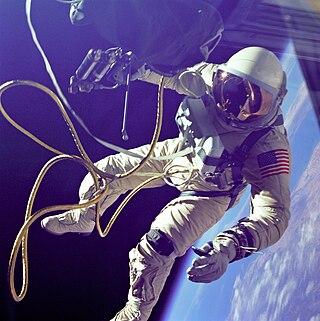
Gemini 4 was the second crewed spaceflight in NASA's Project Gemini, occurring in June 1965. It was the tenth crewed American spaceflight. Astronauts James McDivitt and Ed White circled the Earth 66 times in four days, making it the first US flight to approach the five-day flight of the Soviet Vostok 5. The highlight of the mission was the first space walk by an American, during which White floated free outside the spacecraft, tethered to it, for approximately 23 minutes.

Gemini 7 was a 1965 crewed spaceflight in NASA's Gemini program. It was the fourth crewed Gemini flight, the twelfth crewed American spaceflight, and the twenty-first crewed spaceflight including Soviet flights and X-15 flights above the Kármán line. The crew of Frank Borman and Jim Lovell spent nearly 14 days in space, making a total of 206 orbits. Their spacecraft was the passive target for the first crewed space rendezvous performed by the crew of Gemini 6A.

Gemini 6A was a 1965 crewed United States spaceflight in NASA's Gemini program. The mission, flown by Wally Schirra and Thomas P. Stafford, achieved the first crewed rendezvous with another spacecraft, its sister Gemini 7. Although the Soviet Union had twice previously launched simultaneous pairs of Vostok spacecraft, these established radio contact with each other, but they had no ability to adjust their orbits in order to rendezvous and came no closer than several kilometers of each other, while the Gemini 6 and 7 spacecraft came as close as one foot (30 cm) and could have docked had they been so equipped.

Gemini 8 was the sixth crewed spaceflight in NASA's Gemini program. It was launched on March 16, 1966, and was the 14th crewed American flight and the 22nd crewed spaceflight overall. The mission conducted the first docking of two spacecraft in orbit, but also suffered the first critical in-space system failure of a U.S. spacecraft which threatened the lives of the astronauts and required an immediate abort of the mission. The crew returned to Earth safely.

Gemini 9A was a 1966 crewed spaceflight in NASA's Gemini program. It was the seventh crewed Gemini flight, the 13th crewed American flight and the 23rd spaceflight of all time. The original crew for Gemini 9, command pilot Elliot See and pilot Charles Bassett, were killed in a crash on February 28, 1966, while flying a T-38 jet trainer to the McDonnell Aircraft plant in St. Louis, Missouri to inspect their spacecraft. Their deaths promoted the backup crew, Thomas P. Stafford and Eugene Cernan, to the prime crew. The mission was renamed Gemini 9A after the original May 17 launch was scrubbed when the mission's Agena Target Vehicle was destroyed after a launch failure. The mission was flown June 3–6, 1966, after launch of the backup Augmented Target Docking Adaptor (ATDA). Stafford and Cernan rendezvoused with the ATDA, but were unable to dock with it because the nose fairing had failed to eject from the docking target due to a launch preparation error. Cernan performed a two-hour extravehicular activity, during which it was planned for him to demonstrate free flight in a self-contained rocket pack, the USAF Astronaut Maneuvering Unit. He was unable to accomplish this due to stress, fatigue, and overheating.

Gemini 11 was the ninth crewed spaceflight mission of NASA's Project Gemini, which flew from September 12 to 15, 1966. It was the 17th crewed American flight and the 25th spaceflight to that time. Astronauts Charles "Pete" Conrad Jr. and Richard F. Gordon Jr. performed the first direct-ascent rendezvous with an Agena Target Vehicle, docking with it 1 hour 34 minutes after launch; used the Agena rocket engine to achieve a record high-apogee Earth orbit; and created a small amount of artificial gravity by spinning the two spacecraft connected by a tether. Gordon also performed two extra-vehicular activities for a total of 2 hours 41 minutes.

Gemini 12 was a 1966 crewed spaceflight in NASA's Project Gemini. It was the 10th and final crewed Gemini flight, the 18th crewed American spaceflight, and the 26th spaceflight of all time, including X-15 flights over 100 kilometers (54 nmi). Commanded by Gemini VII veteran James A. Lovell, the flight featured three periods of extravehicular activity (EVA) by rookie Edwin "Buzz" Aldrin, lasting a total of 5 hours and 30 minutes. It also achieved the fifth rendezvous and fourth docking with an Agena target vehicle.

STS-74 was the fourth mission of the US/Russian Shuttle-Mir Program, and the second docking of the Space Shuttle with Mir. Space Shuttle Atlantis lifted off from Kennedy Space Center launch pad 39A on 12 November 1995. The mission ended 8 days later with the landing of Atlantis back at Kennedy. It was the second in a series of seven straight missions to the station flown by Atlantis.

Thomas Patten Stafford is an American former Air Force officer, test pilot, and NASA astronaut, and one of 24 astronauts who flew to the Moon. He also served as Chief of the Astronaut Office from 1969 to 1971.

Soyuz TM-23 was a Soyuz spaceflight which launched on February 21, 1996, to Mir. The spacecraft launched from Baikonur Cosmodrome, and after two days of flight, Yuri Onufrienko and Yury Usachov docked with Mir and became the 21st resident crew of the Station. On September 2, 1996, after 191 days docked with Mir, the ship undocked with the launch crew and Claudie André-Deshays onboard, before eventually landing 107 km (66 mi) south west of Akmola, Kazakhstan.

Project Gemini was the second United States human spaceflight program to fly. Conducted after the first, Project Mercury, and while the Apollo program was still in development, Gemini was conceived in 1961 and concluded in 1966. The Gemini spacecraft carried a two-astronaut crew. Ten Gemini crews and 16 individual astronauts flew low Earth orbit (LEO) missions during 1965 and 1966.
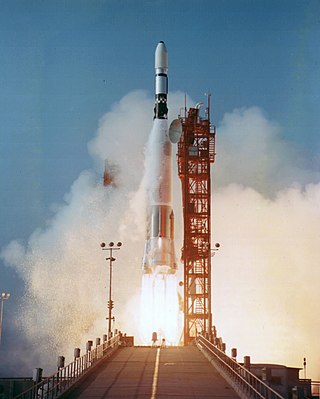
The Atlas-Agena was an American expendable launch system derived from the SM-65 Atlas missile. It was a member of the Atlas family of rockets, and was launched 109 times between 1960 and 1978. It was used to launch the first five Mariner uncrewed probes to the planets Venus and Mars, and the Ranger and Lunar Orbiter uncrewed probes to the Moon. The upper stage was also used as an uncrewed orbital target vehicle for the Gemini crewed spacecraft to practice rendezvous and docking. However, the launch vehicle family was originally developed for the Air Force and most of its launches were classified DoD payloads.
Advanced Gemini is a number of proposals that would have extended the Gemini program by the addition of various missions, including crewed low Earth orbit, circumlunar and lunar landing missions. Gemini was the second crewed spaceflight program operated by NASA, and consisted of a two-seat spacecraft capable of maneuvering in orbit, docking with uncrewed spacecraft such as Agena Target Vehicles, and allowing the crew to perform tethered extra-vehicular activities.

